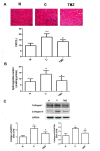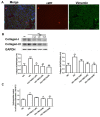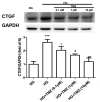Trimetazidine inhibits cardiac fibrosis by reducing reactive oxygen species and downregulating connective tissue growth factor in streptozotocin-induced diabetic rats
- PMID: 31363380
- PMCID: PMC6614713
- DOI: 10.3892/etm.2019.7705
Trimetazidine inhibits cardiac fibrosis by reducing reactive oxygen species and downregulating connective tissue growth factor in streptozotocin-induced diabetic rats
Abstract
Diabetes may affect myocardial fibrosis through oxidative stress. Trimetazidine (TMZ) is an anti-anginal agent. The present study aimed to determine the modulatory effect of TMZ on reactive oxygen species (ROS) and connective tissue growth factor (CTGF) expression and to evaluate the potential of TMZ to improve diastolic function in streptozotocin (STZ)-induced diabetic rats. After treating STZ-induced diabetic rats with TMZ for 16 weeks, a decrease in malondialdehyde levels, cardiac collagen volume fraction, left ventricular (LV) end-diastolic pressure and protein expression of collagen-I (Col I), Col III and CTGF compared with those in diabetic control rats was observed. In vitro, TMZ inhibited Col I, Col III and CTGF protein expression in cardiac fibroblasts treated with high glucose and decreased intracellular ROS generation and hydroxyproline content in the cell culture medium of cardiac fibroblasts. TMZ markedly improved cardiac fibrosis and diastolic function in diabetic rats. This effect was associated with a reduction in ROS production and CTGF expression in cardiac fibroblasts. The present study suggests that TMZ may be beneficial for protecting the hearts of diabetic patients.
Keywords: cardiac fibrosis; connective tissue growth factor; diabetic rat; reactive oxygen species; trimetazidine.
Figures





Similar articles
-
Trimetazidine inhibits pressure overload-induced cardiac fibrosis through NADPH oxidase-ROS-CTGF pathway.Cardiovasc Res. 2010 Oct 1;88(1):150-8. doi: 10.1093/cvr/cvq181. Epub 2010 Jun 9. Cardiovasc Res. 2010. PMID: 20534773
-
Trimetazidine protects against myocardial ischemia/reperfusion injury by inhibiting excessive autophagy.J Mol Med (Berl). 2018 Aug;96(8):791-806. doi: 10.1007/s00109-018-1664-3. Epub 2018 Jun 29. J Mol Med (Berl). 2018. PMID: 29955901
-
The effects of chronic trimetazidine treatment on mechanical function and fatty acid oxidation in diabetic rat hearts.Can J Physiol Pharmacol. 2007 May;85(5):527-35. doi: 10.1139/y07-036. Can J Physiol Pharmacol. 2007. PMID: 17632588
-
Peroxisome proliferator-activated receptor-gamma activation attenuates cardiac fibrosis in type 2 diabetic rats: the effect of rosiglitazone on myocardial expression of receptor for advanced glycation end products and of connective tissue growth factor.Basic Res Cardiol. 2010 May;105(3):399-407. doi: 10.1007/s00395-009-0071-x. Epub 2009 Oct 23. Basic Res Cardiol. 2010. PMID: 19902320
-
Trimetazidine Inhibits Renal Tubular Epithelial Cells to Mesenchymal Transition in Diabetic Rats via Upregulation of Sirt1.Front Pharmacol. 2020 Jul 29;11:1136. doi: 10.3389/fphar.2020.01136. eCollection 2020. Front Pharmacol. 2020. PMID: 32848753 Free PMC article.
Cited by
-
Effect of trimetazidine on left ventricular functions and cardiac biomarkers in diabetic patients with left ventricular diastolic dysfunction: a randomized controlled trial.Sci Rep. 2025 Jan 16;15(1):2115. doi: 10.1038/s41598-024-83213-w. Sci Rep. 2025. PMID: 39814796 Free PMC article. Clinical Trial.
-
The Diabetic Cardiac Fibroblast: Mechanisms Underlying Phenotype and Function.Int J Mol Sci. 2020 Feb 1;21(3):970. doi: 10.3390/ijms21030970. Int J Mol Sci. 2020. PMID: 32024054 Free PMC article. Review.
-
Characterisation of the Myocardial Mitochondria Structural and Functional Phenotype in a Murine Model of Diabetic Cardiomyopathy.Front Physiol. 2021 Sep 1;12:672252. doi: 10.3389/fphys.2021.672252. eCollection 2021. Front Physiol. 2021. PMID: 34539423 Free PMC article.
-
Trimetazidine Affects Mitochondrial Calcium Uniporter Expression to Restore Ischemic Heart Function via Reactive Oxygen Species/NFκB Pathway Inhibition.J Cardiovasc Pharmacol. 2023 Aug 1;82(2):104-116. doi: 10.1097/FJC.0000000000001434. J Cardiovasc Pharmacol. 2023. PMID: 37163369 Free PMC article.
-
Type 1 diabetes, its complications, and non-ischemic cardiomyopathy: a mendelian randomization study of European ancestry.Cardiovasc Diabetol. 2024 Jan 13;23(1):31. doi: 10.1186/s12933-023-02117-7. Cardiovasc Diabetol. 2024. PMID: 38218861 Free PMC article.
References
-
- Shamhart PE, Luther DJ, Hodson BR, Koshy JC, Ohanyan V, Meszaros JG. Impact of type 1 diabetes on cardiac fibroblast activation: Enhanced cell cycle progression and reduced myofibroblast content in diabetic myocardium. Am J Physiol Endocrinol Metab. 2009;297:E1147–E1153. doi: 10.1152/ajpendo.00327.2009. - DOI - PubMed
-
- van Heerebeek L, Hamdani N, Handoko ML, Falcao-Pires I, Musters RJ, Kupreishvili K, Ijsselmuiden AJ, Schalkwijk CG, Bronzwaer JG, Diamant M, et al. Diastolic stiffness of the failing diabetic heart: Importance of fibrosis, advanced glycation end products, and myocyte resting tension. Circulation. 2008;117:43–51. doi: 10.1161/CIRCULATIONAHA.108.778167. - DOI - PubMed
LinkOut - more resources
Full Text Sources
Miscellaneous
